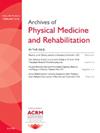NIDILRR ARRT: Intersecting Marginalized Identities Among People with Disabilities: Impact on Access to Employment Support Resources and Employment Outcomes
IF 3.6
2区 医学
Q1 REHABILITATION
Archives of physical medicine and rehabilitation
Pub Date : 2025-04-01
DOI:10.1016/j.apmr.2025.01.006
引用次数: 0
Abstract
Objectives
To examine if demographic factors impact the disparity of resources supporting employment (RSE) and employment among people with disabilities (PWD).
Design
Prospective cohort study with a 2-year follow-up.
Setting
A nationwide disability research registry at the University of Washington used convenience sampling to recruit community-dwelling individuals with multiple sclerosis, muscular dystrophy, spinal cord injury, or postpolio syndrome, resulting in a sample size of over 2000 individuals from 2009 to 2017.
Participants
This study comprised 920 working-age individuals from 2014 to 2017, with more non-Hispanic White participants (86%) than Black, Indigenous, and People of Color.
Interventions
Not applicable.
Main Outcome Measures
RSE (unawareness and level of availability, score range, 0-15) was assessed using 3 questions from the environmental item bank, covering disability accommodation, job placement and training, as well as information on work and volunteer opportunities. Additionally, participants’ employment status (employed and working hours for pay) was determined by their reported weekly hours worked for pay.
Results
PWD who belong to marginalized groups based on race, sex, age, education, and household income reported lower access to RSE and worse employment outcomes. One point higher in RSE was associated with lower unemployment (odds ratio, 0.61; 95% confidence interval, 0.46-0.81) after adjusting for confounding variables and demographics. Significant interactions on employment were found between RSE and education, as well as between RSE and household income. The impact of RSE on employment status was more substantial for PWD with a bachelor's degree or high household income compared with their counterparts with a high-school education or lower and those with low household income.
Conclusions
Results suggest that marginalized PWD have less access to RSE, and this inequality directly affects subsequent employment rates, particularly PWD with lower education and household income. Ensuring equitable job opportunities requires increased allocation of RSE for marginalized PWD.
Disclosures
none. The contents of this report were developed under a grant from the National Institute on Disability, Independent Living, and Rehabilitation Research (NIDILRR grant number H133B130018). National Institute on Disability, Independent Living, and Rehabilitation Research (NIDILRR) is a Center within the Administration for Community Living (ACL), Department of Health and Human Services (HHS). The contents of this report do not necessarily represent the policy of NIDILRR, ACL, or HHS, and you should not assume endorsement by the Federal Government.
残疾人边缘化身份的交叉:对获得就业支持资源和就业成果的影响
目标研究人口统计学因素是否会影响残疾人就业支持资源(RSE)和就业的差异.设计前瞻性队列研究,随访 2 年.设置华盛顿大学的一个全国性残疾研究登记处采用方便抽样的方式招募居住在社区的多发性硬化症患者、肌肉萎缩症患者、脊髓损伤患者或小儿麻痹后遗症患者,2009 年至 2017 年的样本量超过 2000 人.干预措施不适用。主要结果测量使用环境项目库中的 3 个问题对 RSE(不了解情况和可用性水平,得分范围为 0-15)进行评估,这些问题涉及残疾便利、工作安置和培训,以及工作和志愿者机会信息。此外,参与者的就业状况(就业和带薪工作时间)由他们报告的每周带薪工作时间决定。结果根据种族、性别、年龄、教育程度和家庭收入,属于边缘化群体的残疾人获得 RSE 的机会较少,就业结果较差。在对混杂变量和人口统计学因素进行调整后,RSE 高一分与低失业率相关(几率比为 0.61;95% 置信区间为 0.46-0.81)。在 RSE 与教育程度以及 RSE 与家庭收入之间发现了对就业的显著交互作用。结果表明,边缘化的残疾人获得 RSE 的机会较少,这种不平等直接影响了他们之后的就业率,尤其是教育程度和家庭收入较低的残疾人。要确保公平的就业机会,就必须为边缘化的残疾人分配更多的 RSE。本报告的内容是在国家残疾、独立生活和康复研究所(NIDILRR)的资助下编写的(NIDILRR 资助编号 H133B130018)。国家残疾、独立生活和康复研究所 (NIDILRR) 是美国卫生与公众服务部 (HHS) 社区生活管理局 (ACL) 下属的一个中心。本报告的内容并不一定代表 NIDILRR、ACL 或 HHS 的政策,您不应认为本报告得到了联邦政府的认可。
本文章由计算机程序翻译,如有差异,请以英文原文为准。
求助全文
约1分钟内获得全文
求助全文
来源期刊
CiteScore
6.20
自引率
4.70%
发文量
495
审稿时长
38 days
期刊介绍:
The Archives of Physical Medicine and Rehabilitation publishes original, peer-reviewed research and clinical reports on important trends and developments in physical medicine and rehabilitation and related fields. This international journal brings researchers and clinicians authoritative information on the therapeutic utilization of physical, behavioral and pharmaceutical agents in providing comprehensive care for individuals with chronic illness and disabilities.
Archives began publication in 1920, publishes monthly, and is the official journal of the American Congress of Rehabilitation Medicine. Its papers are cited more often than any other rehabilitation journal.

 求助内容:
求助内容: 应助结果提醒方式:
应助结果提醒方式:


